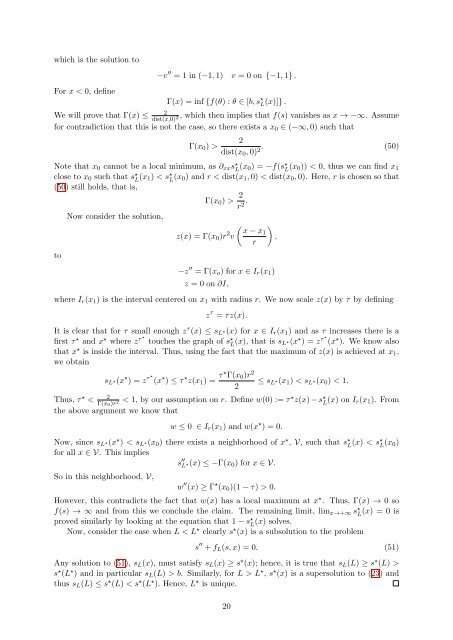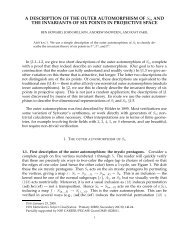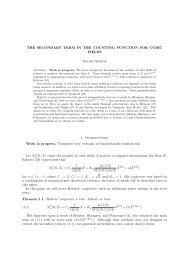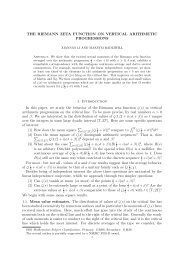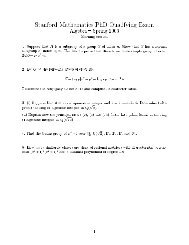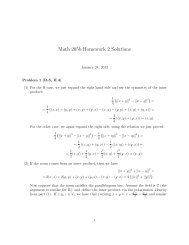Traveling Wave Solutions in a Reaction-Diffusion Model for Criminal ...
Traveling Wave Solutions in a Reaction-Diffusion Model for Criminal ...
Traveling Wave Solutions in a Reaction-Diffusion Model for Criminal ...
Create successful ePaper yourself
Turn your PDF publications into a flip-book with our unique Google optimized e-Paper software.
which is the solution to<br />
For x < 0, def<strong>in</strong>e<br />
−v ′′ = 1 <strong>in</strong> (−1, 1) v = 0 on {−1, 1} .<br />
Γ(x) = <strong>in</strong>f {f(θ) : θ ∈ [b, s ⋆ L(x)]} .<br />
2<br />
We will prove that Γ(x) ≤ dist(x,0) 2 , which then implies that f(s) vanishes as x → −∞. Assume<br />
<strong>for</strong> contradiction that this is not the case, so there exists a x0 ∈ (−∞, 0) such that<br />
Γ(x0) ><br />
2<br />
. (50)<br />
dist(x0, 0) 2<br />
Note that x0 cannot be a local m<strong>in</strong>imum, as ∂xxs⋆ L (x0) = −f(s⋆ L (x0)) < 0, thus we can f<strong>in</strong>d x1<br />
close to x0 such that s⋆ L (x1) < s⋆ L (x0) and r < dist(x1, 0) < dist(x0, 0). Here, r is chosen so that<br />
(50) still holds, that is,<br />
Γ(x0) > 2<br />
.<br />
r2 to<br />
Now consider the solution,<br />
z(x) = Γ(x0)r 2 <br />
x − x1<br />
v ,<br />
r<br />
−z ′′ = Γ(xo) <strong>for</strong> x ∈ Ir(x1)<br />
z = 0 on ∂I,<br />
where Ir(x1) is the <strong>in</strong>terval centered on x1 with radius r. We now scale z(x) by τ by def<strong>in</strong><strong>in</strong>g<br />
z τ = τz(x).<br />
It is clear that <strong>for</strong> τ small enough zτ (x) ≤ sL⋆(x) <strong>for</strong> x ∈ Ir(x1) and as τ <strong>in</strong>creases there is a<br />
first τ ⋆ and x⋆ where zτ ⋆<br />
touches the graph of s⋆ L (x), that is sL⋆(x⋆ ) = zτ ⋆<br />
(x⋆ ). We know also<br />
that x⋆ is <strong>in</strong>side the <strong>in</strong>terval. Thus, us<strong>in</strong>g the fact that the maximum of z(x) is achieved at x1,<br />
we obta<strong>in</strong><br />
sL⋆(x⋆ τ ⋆<br />
) = z (x ⋆ ) ≤ τ ⋆ z(x1) = τ ⋆Γ(x0)r2 2<br />
Thus, τ ⋆ <<br />
the above argument we know that<br />
≤ sL ⋆(x1) < sL ⋆(x0) < 1.<br />
2<br />
Γ(x0)r 2 < 1, by our assumption on r. Def<strong>in</strong>e w(0) := τ ⋆ z(x) − s ⋆ L (x) on Ir(x1). From<br />
w ≤ 0 ∈ Ir(x1) and w(x ⋆ ) = 0.<br />
Now, s<strong>in</strong>ce sL ⋆(x⋆ ) < sL ⋆(x0) there exists a neighborhood of x ⋆ , V, such that s ⋆ L (x) < s⋆ L (x0)<br />
<strong>for</strong> all x ∈ V. This implies<br />
s ′′ L ⋆(x) ≤ −Γ(x0) <strong>for</strong> x ∈ V.<br />
So <strong>in</strong> this neighborhood, V,<br />
w ′′ (x) ≥ Γ ⋆ (x0)(1 − τ) > 0.<br />
However, this contradicts the fact that w(x) has a local maximum at x⋆ . Thus, Γ(x) → 0 so<br />
f(s) → ∞ and from this we conclude the claim. The rema<strong>in</strong><strong>in</strong>g limit, limx→+∞ s⋆ L (x) = 0 is<br />
proved similarly by look<strong>in</strong>g at the equation that 1 − s⋆ L (x) solves.<br />
Now, consider the case when L < L ⋆ clearly s ⋆ (x) is a subsolution to the problem<br />
s ′′ + fL(s, x) = 0. (51)<br />
Any solution to (51), sL(x), must satisfy sL(x) ≥ s ⋆ (x); hence, it is true that sL(L) ≥ s ⋆ (L) ><br />
s ⋆ (L ⋆ ) and <strong>in</strong> particular sL(L) > b. Similarly, <strong>for</strong> L > L ⋆ , s ⋆ (x) is a supersolution to (23) and<br />
thus sL(L) ≤ s ⋆ (L) < s ⋆ (L ⋆ ). Hence, L ⋆ is unique.<br />
20


